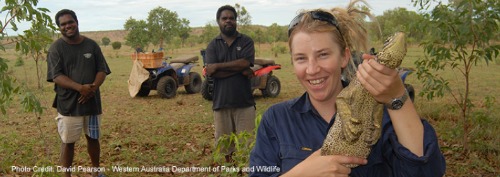17 June 2014
New research is underway to investigate whether goannas can be taught to avoid eating cane toads at a remote site in the east Kimberley, close to the invasion front of cane toads.
The team comprises researchers from the University of Sydney and the WA Department of Parks and Wildlife, and the Balanggarra Rangers with support from the Kimberley Land Council.
Three of the five species of the goannas found in the region are thought to be heavily impacted by toads. The team has been studying two of these – the yellow spotted monitor (Varanus panoptes) and the sand goanna (Varanus gouldii) – to learn more about their ecology.
Goannas are especially susceptible to the impacts of toads because they are apex predators and can locate and consume toads even when toads are in low densities. The Balanggarra people also have an interest in maintaining healthy populations because goannas are a popular bush tucker.
Around 70 goannas have been fitted with tail transmitters and are periodically tracked and recaptured. Cameras have also been set up around their burrows to monitor their activities.
What is taste aversion training?
The goannas are regularly radio-tracked. Once located, they are offered a small cane toad dangling by a fine cord from a fishing rod. Their response (eaten or rejected) is recorded and the team has found that if a goanna has eaten a small non-lethal toad, in subsequent trials they usually won’t eat another. This taste aversion training could prevent goannas from eating larger toads that could kill them when the main toad front arrives. The main front is expected during the wet season at the end of 2014.
How fast are the toads advancing?
Cane toads entered the Kimberley region from the Northern Territory in 2009 and are moving at around 50 kilometres per year. Earlier research has shown that the speed of their progress has actually been increasing as the species evolves. The front is much more spread out than previously thought, with the faster, bigger toads evolving to have longer legs and moving up to eight months in front of the main pack.
About the study site
Since October 2013 researcher Georgia Ward-Fear and the team have been travelling to the site in the Balanggarra ranger boat, crossing the vast West Arm of the Ord River and riding the incoming tide many kilometres up the Forrest River to Oombulgurri.
The abandoned community sits on the edge of a vast floodplain bounded by rocky sandstone escarpment, approximately 50 km north-west of Wyndham, and is home to the team for up to three weeks every month.
A collaborative research effort
The Balanggarra Rangers are an integral part of the project. They are involved in all aspects of the field work and bring exceptional local knowledge and observational skills to the project. Georgia also draws on the expertise and experience of Principal Research Scientist David Pearson and Professor Rick Shine.
This research is partly supported by funding from the Australian Government’s NERP Northern Australia Hub. The Western Australian Government’s Kimberley Science and Conservation Strategy provides employment funds for Balanggarra rangers and the WA Department of Parks and Wildlife funds logistics, supplies and staff time.
Want to know more about the Resilient Landscapes Hub's activities and our research into practical solutions to environmental problems? Stay informed about activities, research, publications, events and more through the Hub newsletter.